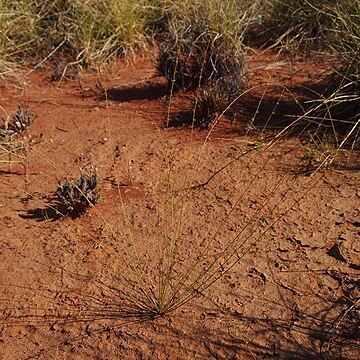Erect, glabrous annual, 6-50 cm long. Root fusiform, up to 5 cm long, 1½ mm diam. at the base, attenuate, with fibrous ramifications. Stem gradually attenuate to the almost filiform angular apex, little branched and leafy below, terete, striate, internodes ½-3 cm long. Leaves linear, sessile, base attenuate, 7½-20 by 1/5-2 mm, lower obtuse, upper acute to mucronate, nervation absent or midrib visible. Racemes 1-20 cm long. Flowers minute yellow, upper groups 1-3 fis and 2 bracteoles, lower groups with more bracteoles and up to 5 fis. Bracts roundish ovate, strongly acuminate, fimbriate, dentate, ¾-1 by ½ mm, membranous except the midrib. Bracteoles like the bracts but more dentate and less acuminate. Pedicels ¾-1¼ mm. Calyx-tube ½ mm high, lobes ovate-acuminate, ½ mm long, irregularly fimbriate-dentate, margin membranous. Corolla inserted on the margin of the calyx-tube, sympetalous, hypocraterimorphous, tube cylindrical, 2 by ½ mm, divided into 5 petals in the lower portion over ¼ mm, lobes ovate-oblong, strongly acuminate, ca ¾ mm long. Filaments filiform, 2 shorter ones reaching the middle, 3 longer ones the margin of the corolla-tube; anthers oblong, very obtuse and emarginate at base and apex, 0.6 by 0.3 mm, introrse, dithecic, 4-locular. Ovary sub globose, 0.3-0.4 mm diam. 3-lo-bate, 3-celled. Style straight, 0.4 mm long, with 3 linear stigmas. Cocci 3, roundish ovate, 1¼ by 1 mm, reticulate.
More
Erect annual to 80 cm high, glabrous, rarely sparsely puberulent. Stems slender to robust. Leaves narrowly linear to linear-lanceolate, rarely scale-like, to 50 mm long. Inflorescence a lax cylindrical spike; flowers in many-bracted clusters of 1-5, subsessile to shortly pedicellate; bracts acuminate, fimbriate-dentate. Hypanthium 0.3-0.8 mm long. Sepals 0.6-0.8 mm long. Corolla pale green to pale yellow; tube 2-3.5 mm long; lobes 0.7-1.7 mm long, acuminate. Gynoecium 3-partite. Cocci ellipsoidal to obovoid or globular, 0.8-3.2 mm long, rugose to tuberculate, glabrous to pubescent; basal cavity absent.
Lank herb mostly in grassfields, savannahs and abandoned fields, in both wet and dry spots, in Sumatra at 600-1400, but in E. Malaysia & Micronesia below 300 m, in the Philippines ascending to 1500 m. Fl. mostly in April-May together with the grasses.
More
Grows in wooded grasslands.

